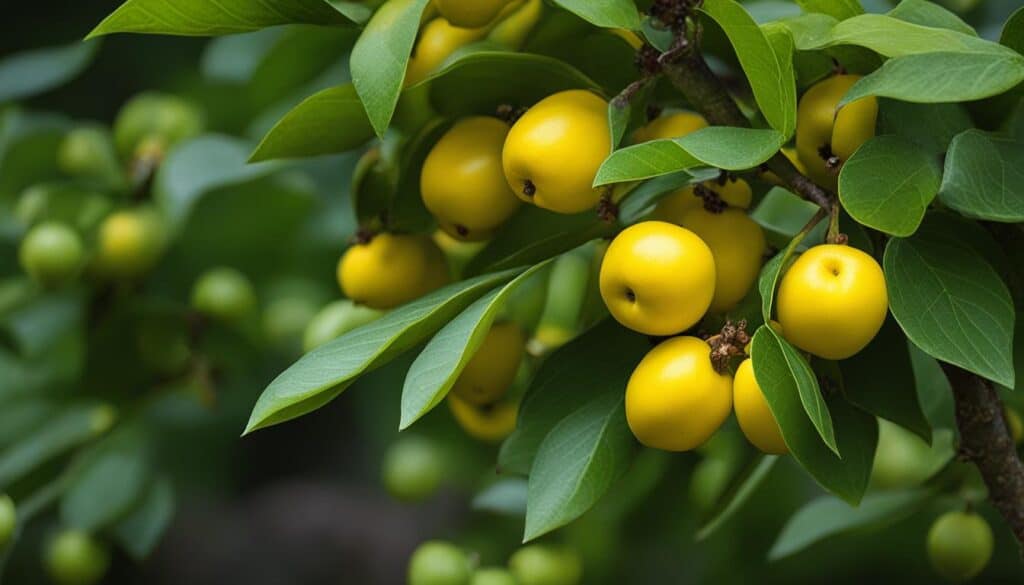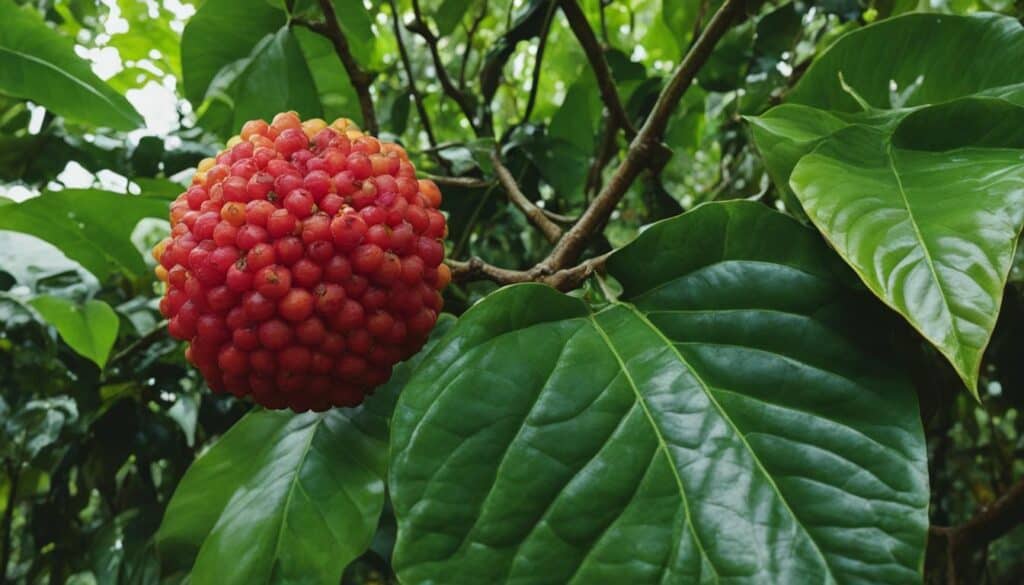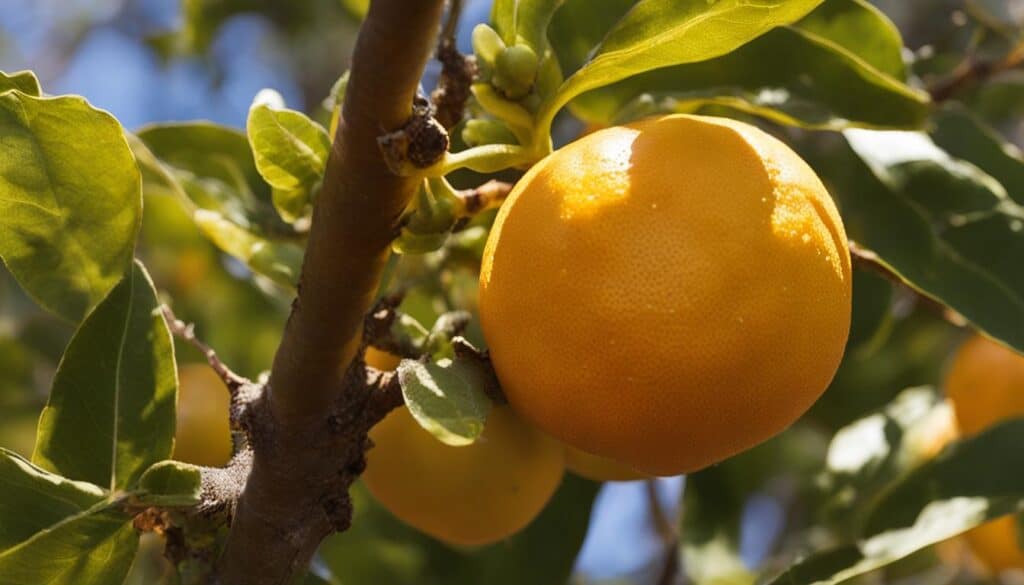Greetings, fellow fruit enthusiasts! Today, I am excited to dive into the fascinating world of nance fruit. Have you ever wondered where this delightful fruit comes from or about its country of origin? Join me on this fruity adventure as we unravel the mysteries surrounding the nance fruit origin and its geographical location.
Key Takeaways:
- Nance fruits are native to regions of the Americas, primarily found in Central America, South America, and parts of Mexico.
- They thrive in tropical and subtropical climates, such as Brazil, Costa Rica, Panama, and Mexico.
- The trees that bear nance fruit can be found in tropical deciduous forests and Amazonian savannas.
- While nance fruits are primarily consumed in their native growing regions, they have expanded to the Caribbean and some parts of Southern California.
- The delicious journey into the origins of nance fruit awaits! Let’s uncover more about this tropical delight.
Description and Taste of Nance Fruit
Nance fruits are small, round to ovate fruits with a diameter of 1 to 2 centimeters. They have a thin, smooth, semi-glossy, and taut skin that transitions from green to golden yellow, yellow-orange, or red, depending on the variety.
The flesh of the fruit is oily, aqueous, and pulpy, ranging in color from white to pale yellow. Nance fruits emit a strong and distinct aroma with floral, fruity, and sweet notes, mixed with a peculiar cheesy scent.
“The aroma of ripe nance fruit is absolutely captivating. It’s a delightful fusion of floral and fruity scents, with an underlying hint of cheesiness that adds to its unique character,” says Maria Rodriguez, a fruit enthusiast.
When ripe, the fruits have an acidic and subtly sweet taste with fruity nuances of lychees, bananas, and crabapples, accompanied by sharp undertones reminiscent of Parmesan cheese. The combination of flavors creates a delightful balance that is both intriguing and satisfying.
Seasons and Availability of Nance Fruit
Nance fruits are a delicious tropical delicacy that is available during specific seasons in certain regions. Understanding the nance fruit seasons and availability can help you plan when to enjoy these flavorful fruits.
In their native growing regions, such as Central America, South America, Mexico, the Caribbean, and some parts of Southern California, nance fruits can be found in fresh markets and other outlets during the spring through early summer. The peak season for nance fruits occurs from April to June, when they are at their freshest and most abundant. It’s the perfect time to indulge in the unique flavors of nance fruits.
However, outside of these specific regions, finding fresh nance fruits can be more challenging. In the United States and other countries, fresh nance fruits are not commonly available. But don’t worry! You can still enjoy the taste and experience of nance fruits by purchasing them in canned form through select online retailers, grocers, and distributors. This allows you to savor the distinct flavors of nance fruits no matter where you are located.
Availability of Nance Fruit
| Region | Season |
|---|---|
| Central America | Spring through early summer (April – June) |
| South America | Spring through early summer (April – June) |
| Mexico | Spring through early summer (April – June) |
| The Caribbean | Spring through early summer (April – June) |
| Southern California | Spring through early summer (April – June) |
| United States and other regions | Canned nance fruits available |
Remember, the availability of nance fruits may vary, so it’s always a good idea to check with local markets or online sources to find out if they are currently in season. Whether you enjoy them fresh or canned, nance fruits are a delightful addition to your culinary adventures.
Culinary Uses of Nance Fruit
Nance fruits are incredibly versatile and can be enjoyed in various culinary preparations. Whether you prefer sweet or savory dishes, nance fruit adds a unique and tropical twist to your recipes.
Here are some delightful culinary uses for nance fruit:
Sweet Treats:
- Nance Fruit Snack: In Mexico, nance fruits are commonly sold as a snack in to-go containers. They are sprinkled with lime juice and chili powder, creating a delicious combination of tangy, spicy, and sweet flavors.
- Sliced into Salads: Add a burst of tropical flavor to your salads by slicing nance fruits and tossing them with your greens. The sweet and slightly tangy taste of nance fruit complements fresh vegetables beautifully.
- Blended into Frozen Treats: Freeze nance fruits and blend them with other tropical fruits to create refreshing popsicles, sorbets, or homemade ice cream. The creamy texture and delightful flavor of nance fruit will transport you to a tropical paradise.
- Preserved in Syrup: Enjoy the exotic flavor of nance fruit all year round by preserving them in syrup. The syrup can be used in cocktails, as a topping for pancakes or waffles, or drizzled over desserts.
- Pesada de Nance: In Panama, nance fruits are commonly used to make pesada de Nance, a rich and creamy dessert. This dessert is made by cooking nance fruit with water, sugar, fruits, and cornstarch to achieve a luscious consistency.
- Nicaraguan Raspados: Combine mashed nance fruits with a heated mixture of brown sugar, white sugar, and cinnamon to create a flavorful syrup. Pour this syrup over shaved ice, and you have a delicious Nicaraguan raspado.
Savory Delights:
- In Stews or Rice Dishes: Add nance fruits to savory stews for a touch of sweetness and acidity. They can also be included in rice dishes to enhance the complexity of flavors and add a vibrant twist.
Thirst-Quenching Beverages:
- Smoothies and Juices: Blend nance fruits with other tropical fruits, yogurt, and a splash of juice to create a refreshing and nutrient-packed smoothie. You can also juice nance fruits to make a flavorful and invigorating drink.
- Carbonated Drinks: Add nance fruit syrup or pulp to carbonated water for a unique and tropical homemade soda.
These culinary uses of nance fruit showcase the versatility and exotic flavor it brings to your dishes. Whether you’re craving a sweet treat, a savory delight, or a thirst-quenching beverage, nance fruit adds a burst of tropical goodness to elevate your culinary creations.

Nutritional Value of Nance Fruit
When it comes to health benefits, nance fruit offers an impressive array of nutrients. This small tropical fruit is packed with fiber, calcium, magnesium, vitamin C, potassium, vitamin E, copper, iron, folate, and vitamin K. Let’s take a closer look at the nutritional value of nance fruit:
| Nutrient | Amount per 100g |
|---|---|
| Fiber | 2.7g |
| Calcium | 23mg |
| Magnesium | 18mg |
| Vitamin C | 20mg |
| Potassium | 209mg |
| Vitamin E | 0.29mg |
| Copper | 0.1mg |
| Iron | 0.43mg |
| Folate | 3μg |
| Vitamin K | 0.5μg |
Fiber plays a crucial role in regulating the digestive tract and promoting overall gut health. Meanwhile, calcium and magnesium contribute to strong bones and help control blood pressure levels. Vitamin C is known for its immune-boosting properties, while vitamin E acts as a powerful antioxidant, protecting our cells from damage caused by free radicals. Copper performs an important role in the development of connective tissues in our body, and iron helps carry oxygen to cells. Folate and vitamin K also play essential roles in various bodily functions.
Aside from its nutritional value, nance fruit has been used as a natural dye for cotton and has been traditionally infused into medicines to reduce fevers in Central and South America.
References:
- “USDA FoodData Central”.
- “Nance fruit: A source of carotenoids with potential health benefits.”
Historical Significance of Nance Fruit
Nance fruit holds a special place in the history of the Mayan culture, as it is prominently featured in the ancient Mayan myth known as the Popol Vuh. According to the myth, the demon Vucub-Caquix transforms into a bird and perches on the nance fruit trees, devouring the delicious fruits.
Two courageous Mayan gods, Hunahpu and Xbalanque, are chosen to confront and defeat the demon. After a fierce battle, they successfully vanquish Vucub-Caquix, putting an end to his reign of terror and restoring peace to the world.
“Hunahpu and Xbalanque, the two great heroes, said to each other:
‘What were we thinking? What have we done? It was not right that our creations should endure pains, that we should destroy them! Feel sorry for them, they are unfortunates! As for the demon who injured us, let his power and his authority cease.’
As a result of their victory, Hunahpu and Xbalanque ascend into the sky to become the sun and moon, symbolizing the triumph of good over evil and the eternal cycle of life.
This captivating myth showcases the cultural significance of nance fruit in Mayan folklore and underscores its deep-rooted connection to ancient beliefs and traditions.

| Key Points: |
|---|
| Nance fruit is featured in the Mayan myth of the Popol Vuh. |
| The myth revolves around the defeat of the demon Vucub-Caquix by the Mayan gods Hunahpu and Xbalanque. |
| Hunahpu and Xbalanque’s victory leads to their transformation into the sun and moon. |
| The myth highlights the cultural significance of nance fruit and its association with ancient Mayan beliefs. |
Health Benefits of Nance Fruit
Nance fruit offers several health benefits due to its nutrient content.
1. Good Source of Dietary Fiber: Nance fruit is rich in dietary fiber, which plays a crucial role in promoting a healthy digestive tract. It aids in maintaining bowel regularity and can contribute to weight management.
2. High in Antioxidants: Nance fruits are packed with antioxidants, particularly vitamin C. Antioxidants help protect the body against oxidative stress and reduce the risk of chronic diseases such as heart diseases and strokes.
3. Supports Immune System: Nance fruit contains essential vitamins and minerals that support a healthy immune system. Vitamin C, in particular, plays a vital role in enhancing immune function and protecting against infections.
4. Nutrient-Rich: Nance fruit is a good source of calcium, potassium, magnesium, copper, iron, folate, and vitamin K. These nutrients are important for various bodily functions, including bone health, red blood cell production, and cellular processes.
While nance fruit has demonstrated potential health benefits, further research is necessary to fully understand its specific contributions to overall well-being. Incorporating this tropical fruit into a balanced diet can provide a flavorful and nutritious addition to your meals.

Takeaway:
Nance fruit offers a range of health benefits, from aiding digestion and providing essential nutrients to boosting the immune system and reducing the risk of chronic diseases. Adding this tropical fruit to your diet can help support overall well-being.
Where to Find Nance Fruit
Fresh nance fruit can be challenging to find, especially outside of its native growing regions. In Central America, South America, Mexico, and the Caribbean, nance fruits can be found in local fresh markets during the peak season. However, in other regions, such as the United States, finding fresh nance fruit may be more difficult.
Canned nance fruit can be purchased online through select retailers and distributors, making it more accessible to those interested in trying this tropical delicacy.
For individuals in the United States, here are some online retailers where you can buy canned nance fruit:
| Retailer | Website |
|---|---|
| Fresh Tropical Fruit | https://www.freshtropicalfruit.com |
| Tropical Fruit Box | https://www.tropicalfruitbox.com |
| Exotic Fruits USA | https://www.exoticfruitsusa.com |
These online retailers offer a convenient way to explore the flavors of nance fruit without having to travel to its native growing regions.
“Nance fruit opens up a new world of tropical flavors. With its unique taste and versatility, it’s worth giving it a try!”
How to Identify Ripe Nance Fruit
Identifying ripe nance fruit is crucial to ensure the best flavor and quality. Follow these guidelines to determine if your nance fruit is ripe and ready to enjoy.
- Color: Ripe nance fruit transitions from green to a bright shade of yellow, resembling a yellow bell pepper. Look for a vibrant yellow hue to indicate ripeness.
- Firmness: Gently press the fruit with your fingers. Ripe nance fruit should have a slight give when pressed, indicating its tenderness.
- Smell: Ripe nance fruit emits an intense floral and cheesy aroma. Take a whiff and savor the captivating scent.
- Bruising: Avoid overly ripe fruits with brown spots or bruising. These fruits may be past their prime and could have a compromised taste and texture.
If you have access to wild nance fruit, another way to determine ripeness is to check the ground for fallen fruits. Look for perfectly yellow fruits that have naturally dropped from the tree, indicating their ripeness.
By considering the color, firmness, smell, and the absence of bruising, you can confidently determine if your nance fruit is ripe and ready to be enjoyed in your favorite recipes.
Nance Fruit Ripeness Indicators
| Indicator | Ripe Nance Fruit | Overripe Nance Fruit |
|---|---|---|
| Color | Bright shade of yellow | Brown spots |
| Firmness | Slight give when pressed | Very soft or mushy |
| Smell | Intense floral and cheesy aroma | No distinct aroma or off-putting smell |
| Bruising | Absence of brown spots or bruising | Brown spots or visible bruising |

Now that you know how to identify ripe nance fruit, you can fully enjoy its delightful flavor and incorporate it into your culinary creations.
Precautions and Allergies Related to Nance Fruit
When enjoying the unique flavors of nance fruit, it’s important to be aware of certain precautions and allergies associated with this tropical delicacy.
Nance fruit allergies:
It is worth noting that nance fruit belongs to the same botanical family as acerola cherries. Individuals who have known allergies to acerola cherries may also be allergic to nance fruit. If you have a history of allergic reactions to cherries or related fruits, it is recommended to avoid consuming nance fruit to prevent an allergic reaction.
Nance fruit precautions:
Aside from allergies, there are other precautions to consider when enjoying nance fruit:
- Pit hazards: The pits of nance fruit are not edible and can pose a choking hazard, especially to young children. It is important to remove the pits before consuming the fruit to ensure safety.
- Medication interactions: Currently, there is limited research on the potential interactions between nance fruit and medications. If you are taking any medications, it is advisable to consult with your healthcare provider before including nance fruit in your diet to ensure there are no adverse effects or interactions.
By being aware of these precautions and allergies, you can enjoy nance fruit safely and fully appreciate its unique flavors and culinary uses.
Storing and Freezing Nance Fruit
Fresh nance fruit has a short shelf life and should be consumed when ripe for the best quality and flavor. To extend the storage period, I recommend using two methods: storing the fruits submerged in water and freezing them.
If you’ve harvested or bought a batch of nance fruit and want to keep them fresh and flavorful for a few more days, try storing them submerged in water. This method enhances the fruit’s flavor and consistency, allowing you to enjoy the bright, tropical taste for a longer period. Simply place the fresh nance fruits in a container or a bowl, cover them with water, and keep them in the refrigerator. Remember to change the water daily to maintain freshness.
For longer storage, freezing the nance fruits is a great option. Freezing the fruits can help them stay fresh for a few months, allowing you to enjoy their unique taste even when they are out of season. Start by pitting the nance fruits to remove the pits, as they are not edible and can cause a choking hazard. Once the fruits are pitted, place them in an airtight container or a freezer bag. Make sure to label the container with the date to keep track of the freezing time. When you’re ready to enjoy the frozen nance fruits, simply thaw them in the refrigerator before consuming or using them in your favorite recipes.
By following these proper storage techniques, you can preserve the taste and freshness of nance fruits, ensuring that you have a supply of this exotic tropical delicacy whenever you crave it.
Stay tuned for the next section, where we’ll delve into the conclusion, summarizing the key highlights of our exploration into the world of nance fruit!
Conclusion
In summary, nance fruit is an extraordinary tropical delicacy that originates from Central America, South America, and parts of Mexico. With its one-of-a-kind flavor and aroma, combining fruity and cheesy notes, nance fruit offers a truly unique taste experience.
Although fresh nance fruit may not be easily accessible in all regions, you can still enjoy the delightful flavors by purchasing canned nance fruit from select retailers and online distributors.
Besides its distinct taste, nance fruit also boasts a variety of culinary uses and health benefits. Its high fiber content and rich nutrient profile make it a valuable addition to a well-balanced diet. Whether used in savory dishes, desserts, or beverages, nance fruit adds a flavorful and cultural element to any culinary experience.
So, if you’re looking to explore the world of tropical fruits and expand your palate, give nance fruit a try. Its exotic nature and versatile usage make it a fascinating addition to any adventurous food lover’s repertoire.
FAQ
Where is nance fruit from?
Nance fruit is native to regions of the Americas, particularly Central America, South America, and parts of Mexico.
What is the country of origin of nance fruit?
Nance fruit originates from countries such as Brazil, Costa Rica, Panama, and Mexico.
In what geographical location is nance fruit produced?
Nance fruit is primarily produced in tropical and subtropical climates, mainly in regions such as Brazil, Costa Rica, Panama, and Mexico.
Where is the cultivation region for nance fruit?
Nance fruit is cultivated in the tropical deciduous forests and Amazonian savannas of Central America, South America, and parts of Mexico.
What is the native region of nance fruit?
The native region of nance fruit includes Central America, South America, and parts of Mexico.
Where is nance fruit grown?
Nance fruit is grown in tropical and subtropical regions such as Brazil, Costa Rica, Panama, and Mexico.
What is the habitat of nance fruit?
Nance fruit trees are found in tropical deciduous forests and Amazonian savannas.





Leave a Reply